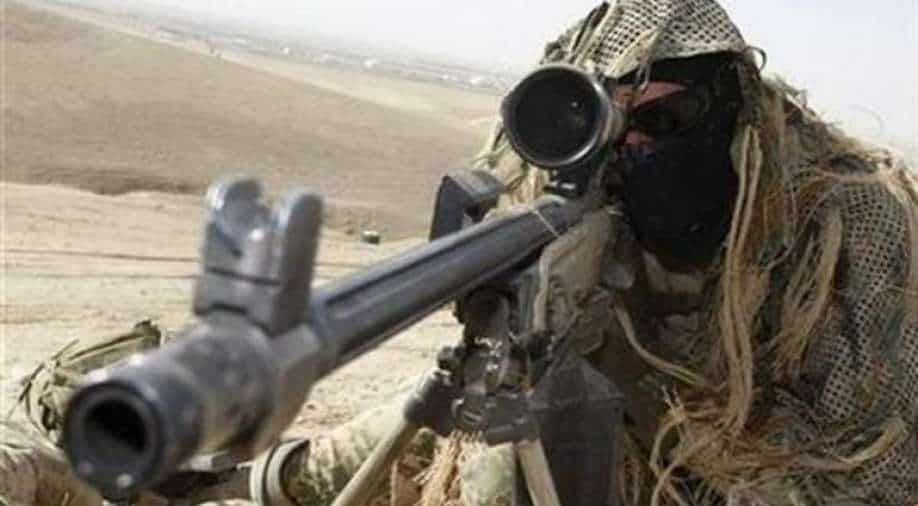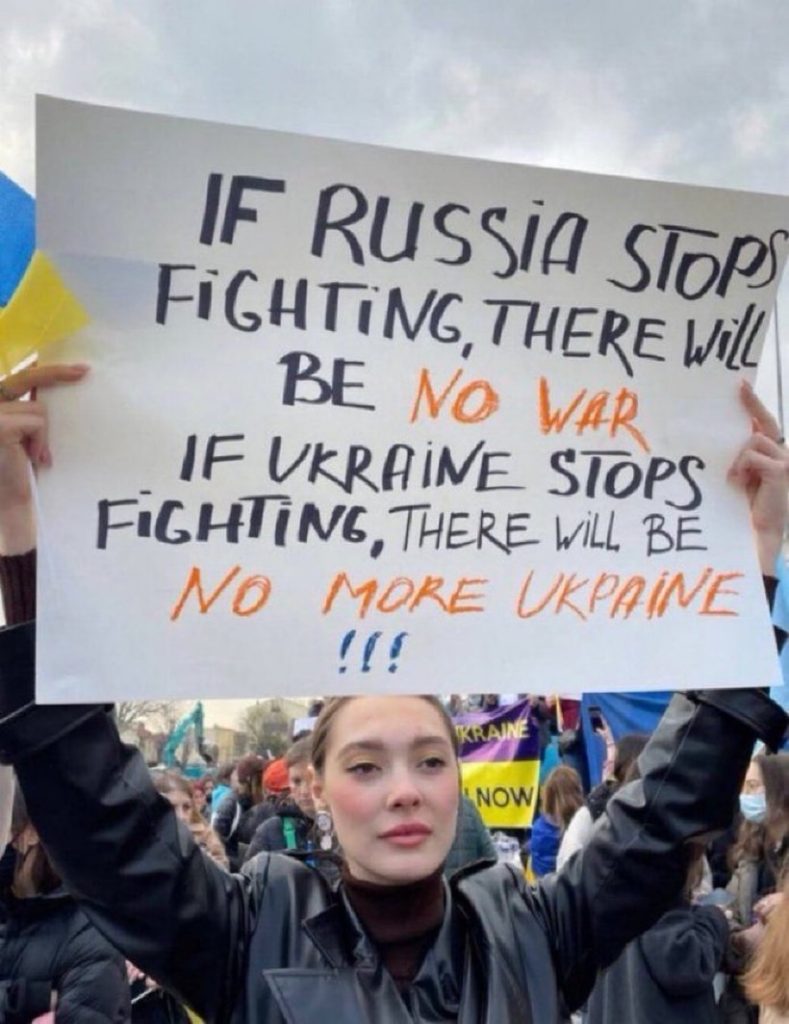Plus: what Russia’s call to Mariupol to surrender means. It can’t capture the city, it will resort to indiscriminate all-out attacks, and it will blame Ukraine for human casualties including collateral damage. A chat with several military analysts about the coming battle.

ABOVE: a Ukrainian serviceman aims towards Russian positions outside the city of Brovary, just east of Kyiv, on 12 March 2022. Photo courtesy of Reuters. Brovary is a main access point to Kyiv and it is where a Russian tank column was ambushed.
21 March 2022 – Russia has lost five battlefield generals in twenty-four days. Ukrainian reports say four were killed by snipers, tentatively confirmed by U.S. intelligence reports.
NOTE: the U.S. had 150 U.S. Army trainers in Ukraine but withdrew them the week before the Russian invasion. The Central Intelligence Agency also had been training Ukrainian special forces and intelligence officers in irregular warfare — that is, paramilitary operations — for eight years at a once secret facility that was revealed during the invasion. President Biden has pledged repeatedly not to commit US military troops on the front lines of a war between Ukraine and Russia, so as not to start World War III. But according to Tim Weiner, the author of the engaging and exhaustive 2007 CIA history “Legacy of Ashes,” the CIA certainly kept a small cadre of CIA paramilitary in Ukraine. Plus U.S. intel is supporting Ukrainian resistance with real-time battlefield intelligence. I’ll cover this in a subsequent post.
Robert Hornfeld, a former SAS soldier and sniper, plus several ex-U.S. military snipers, have been across social media explaining how snipers are trained (in the U.S. most go through the United States Army Sniper Course at Fort Benning, Georgia) and what is happening with these snipers … on both sides of the war. But all say that for Russia to lose five generals in such a short period of time is simply incredible.
And the major reason is because these generals had to go to the front line to discover what was going on and to give orders because Russian communications has failed across the board. Communications have been blocked or destroyed. The inability of junior officers to show initiative has hamstrung their war machine. No one can move without orders – and there are no orders. I will follow up this week with a more detailed explanation of the “why” of the communication breakdown.
My base is Krakow, Poland. It has become a nerve centre of this war for several reasons. It is Poland’s technology centre and for that reason U.S. and European tech companies have relocated Ukraine staff here (the U.S. Embassy in Ukraine also relocated much of its staff here). It now also houses several thousand Ukraine refugees. And it is home to Jagiellonian University, which is not only Poland’s prestige university but the 13th oldest university in continuous operation in the world and often regarded as one of Europe’s most prestigious academic institutions, with a huge complement of historians well versed in the history of Russia, Ukraine and Eastern Europe.
Because of everything I’ve noted in the above paragraph, it has become a wellspring of sources to cover this war. And it has offered some serendipity. Like a chat with an ex-sniper who told me there are several ex-British Army snipers serving in Ukraine, along with at least two ex-US Army snipers. Let’s leave out names and how everybody got there and just make a few points:
1. To be a sniper in the true military sense “is not a man with a rifle shooting from a hidden position. A sniper is first an expert in fieldcraft and second a good shot. He or she can be invisible in front of cover, can stalk the enemy, judge distance, wait for long periods of time, identify a specific target, kill it with one shot and exit without being seen”. In today’s world the amount of intel required for that (and the amount of surveillance tech that goes into that) boggles the mind. In the Ukraine war, drones + intercepted communications play an enormous part.
2. Those five generals. As noted above, they needed to go to the front line to discover what was going on and to give orders. Russian communications have failed. Communications have been blocked or destroyed. The inability of junior officers to show initiative has hamstrung their war machine. No one can move without orders – and there are no orders. To lose five senior officers in such a short time leaves a huge gap in the military hierarchy that will need to be filled by less experienced people. In contrast the UN lost one general officer in twenty years in Afghanistan to artillery fire. Mark Hertling, now retired and formally the Commanding General of United States Army Europe and the Seventh Army, who has served in Armor, Cavalry, planning, operations and training positions, and commanded every organization from Platoon to Field Army, has been posting incredible stuff on Twitter. Through a contact, he sent me a briefing note on the Russian communications failure. More to come later this week.
3. “When a good sniper is on the ground everyone is nervous”. In the Ukraine, the primary purpose is to hold up the Russian army by removing front line leadership (Russian snipers seem to be only picking off Ukraine foot soldiers and civilians). And snipers are trained to create an aura of being very, very dangerous. Current soldiers and former soldiers from the U.S. and the UK who have taught, are teaching sniper skills to Ukrainian special ops have noted “we are training men who have spent their lives hunting in the forests, and that gives them a huge advantage”.
4. Here is what happened with the sniper deaths of two Russian generals (confirmed with a source I have at the OSINT website 19fortyfive, and by Bellingcat): Both generals were shot dead near the frontlines. Both were being trashed by U.S. military intel. They were using unsecured lines to communicate, U.S. intel and Ukrainian forces were able to work out their locations, sniper teams were sent and were able to engage close-up observation, undetected, and execute the kill. In one case, secondary staff were also killed in the same operation.
5. How do snipers calculate distance? They really need to know their math. MOA (minute of angle) is the unit of measurement that snipers use in school to measure accuracy. The greater the distance the sniper is shooting from, the lower the accuracy, as natural forces like wind resistance work on the bullet while it travels through the air. MOA measures the accuracy of the shot taking the distance it was fired from into consideration. And the two biggest variables that affect a bullet’s flight are wind and gravity. When estimating the range of a target, snipers must consider how the wind will affect flight over that distance. Sniper teams can use indicators like smoke or blowing leaves to help them read the wind. Examples provided:
“Using a standard 7.62mm NATO round, judging a target to be 700 meters instead of the actual 725 meters means that you would hit in the range of 13 inches high, depending on the actual weapons system and conditions (barrel length, sight height, density altitude, etc).
Typically, serious long range shooters invest heavily in effective range finders, such as the Vectronix rangefinders, or similar such devices. They emit a laser beam, and the beam is reflected back to the rangefinder, and the time it takes is used to calculate the distance. This is typically the most reliable method of ranging, if one has the time/equipment to do so. It’s limitations are target reflectivity, stability, and quality of the laser and calculation software.
Another method, somewhat less exact, is ranging using milling. The theory of milling targets is based off trigonometry. If a target height or width is known, you can use the angle between the top/bottom or left/right side of the target to approximate distance. The issue with milling targets is that it can be subjective, where I might estimate a target at 1 mil, you may see .95, which gives you 5% difference in range. Also, the shooter may not know the exact width of the target, which is often seen in hunting. The accepted size of a whitetail is 18″ from top of the back to bottom of the chest, but full grown whitetail can be anywhere from 90 to 300+ lbs, depending on where you are hunting, and you can expect the true body height to be significantly different from the 18″.
Ultimately, as will be obvious, the farther a sniper can be from his target and still remain accurate the more effective he is and the less likely he is to be discovered. As I was told:
“Using a 7.62mm round, snipers can shoot nearly silently as long as they’re shooting from over 600 meters. A bullet leaves the rifle barrel faster than the speed of sound. The cracking sound a bullet makes is a tiny sonic boom. Even if a target doesn’t hear the rifle shot, he will hear the bullet fly by. But the drag created by wind resistance on a 7.62mm round as it travels through the air slows the bullet down to sub-sonic speeds at around 600 meters. So at ranges over 600 meters, the bullet no longer makes that distinct cracking sound. If you’re shooting at a target 800 or 1,000 meters out, you could be shooting at that person all day long and they don’t even know they are being shot at.”
Snipers spend plenty of time in school cracking the books and in the classroom learning the principles of ballistics, windage, air density, and many other variables that affect the flight of a bullet. But at the end of the day, it comes down to what snipers call “rounds down range.” Practice practice practice practice down a multi-level, complex firing range.
What happens around Mariupol in the next few days should reveal a lot about the state of the Russian Army. But I cringe with what I think is in store.

The demand that the city be surrendered was really a plea. Saying to the Ukrainians, “we really don’t want to send our army into the town”. The Ukrainian rejection will force the Russians to do the one thing they have so far been very reluctant to do in this campaign – go into a defended city. One analyst told me “they have allowed the Ukrainians time to prepare”.
But my inner soul says Putin’s justification to raze Mariupol to the ground to send a message.
The Russians have so far continued what they have been doing, long-distance bombardment. But that doesnt help them much at this point as they’ve already blown up most of the city. Indeed, they seem to have created a perfect environment for defenders to draw them into street by street fighting. And the Russians have put relatively little effort into such a fight – and at the same time their troops have been in the field now for more than 3 weeks, and are undoubtedly suffering from strain and loss of morale.
The problem is if the Ukrainians do continue to hold the centre, the Russian army will have to go in, and reveal a lot about its training, morale and ability to continue this war. Or just say “Fuck it” and raze the city to the ground.
Because for the Ukrainians the problem is the city is surrounded. It’s not like Kyiev. That means you can lay siege to city. The situation for defenders will go from bad to worst as they run out food, water, etc. You can keep pounding and wait them out. And that, By God, is the “Russian Way of War”. It justifies flattening the city and shooting any survivors. It has nothing to do with fears about urban warfare. And the opportunity for more war crimes.